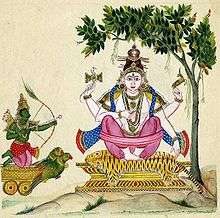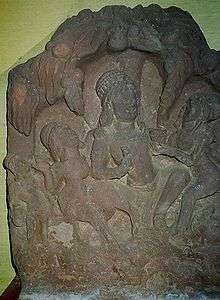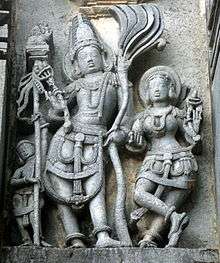Kamadeva
Kamadeva (Sanskrit: कामदेव, IAST: Kāmadeva), Kāma or Manmatha is the Hindu god of human love[2] or desire, often portrayed along with his female counterpart Rati. Kamadeva was son of Lord Vishnu and in some versions he is the son of Lord Brahma. Some narratives also reference Pradyumna, Krishna's son, as a reincarnation of Kamadeva.[2]
| Kamadeva | |
|---|---|
God of Love, Lust and Desire | |
 Kamadev | |
| Other names | Madana |
| Devanagari | कामदेव |
| Sanskrit transliteration | Kāmadeva |
| Affiliation | Deva |
| Abode | Vaikuntha |
| Mantra | काम (kāma)[1] |
| Weapon | Sugarcane bow and floral arrow (pushpa dhanu and pushpa shar) |
| Mount | Parrot |
| Personal information | |
| Parents | Brahma and Saraswati or Vishnu and Lakshmi |
| Consort | Rati |
| Children | Harsha (joy) |
| Equivalents | |
| Greek equivalent | Eros |
Etymology and other names
The name Kama-deva (IAST: kāma-deva) can be translated as 'god of love'. Deva means heavenly or divine, and refers to a deity in Hinduism. Kama (IAST: kāma) means "desire" or "longing", especially as in sensual or sexual love. The name is used in Rig Veda (RV 9, 113. 11).[3] Kamadeva is a name of Vishnu in Vishnu Purana and Bhagavata Purana (SB 5.18.15), and also Krishna as well as Shiva. Kama is also a name used for Agni (Atharva Veda 6.36.3).
Other names used in reference to Kamadeva are Manmatha/Manmathudu (one who agitates), Atanu (one without a body), Ragavrinta (stalk of passion), Ananga (incorporeal), Kandarpa (inflamer even of a god), Madana (intoxicating),[3][4] Manmatha मन्मथ (churner of hearts), Manasija (he who is born of mind, a contraction of the Sanskrit phrase Sah Manasah jāta), Ratikānta (lord of Rati), Pushpavān, Pushpadhanva, Kusumashara कुसुमशर (one with arrow of flowers), Abhipura (also a name for both Brahma and Vishnu[5]), and simply Kāma (desire; longing).
Iconography
Kāmadeva is represented as a young, handsome man who wields a bow and arrows. His bow is made of sugarcane, and his arrows are decorated with five kinds of fragrant flowers.[6][7] The five flowers are white lotus, Ashoka tree flowers, Mango tree flowers, Jasmine flowers and blue lotus flowers. The names of these flowers in Sanskrit in order are Aravinda, Ashoka, Choota, Navamallika, and Neelotpala. A terracotta murti of Kamadeva of great antiquity is housed in the Mathura Museum, UP, India.[8]
Some of the attributes of Kamadeva are: his companions are a cuckoo, a parrot, humming bees, the season of spring, and the gentle breeze. All these are symbols of spring season, when his festival is celebrated as Holi, Holika or Vasanta.
Textual sources

Images and stories about Hindu god Kamadeva are traced to the verses of the Rig Veda and Atharva Veda, although he is better known from the stories of the Puranas.[6]
According to Shiva Purana, Kamadeva is a son or a creation of Brahma. In other sources such as the Skanda Purana, Kamadeva is a brother of Prasuti; they are both the children of Shatarupa created by Brahma. Later interpretations also consider him the son of Vishnu.[9] According to Matsya Purana, Visnu-Krishna and Kamadeva have a historical relationship.[7] In the Harivamsa, his mother is the goddess Lakshmi.[10]
Kamadeva is also mentioned in the 12th-century Javanese poem Smaradahana, a rendering of the myth of Kamadeva's burning by Shiva and fall from heaven to earth. Kama and his consort Rati are referenced as Kamajaya and Kamarati in Kakawin poetry and later Wayang narratives.
Mythology
Kamadeva was married to Ratī, the daughter of Daksha, created from his sweat. Rati is a minor character in many traditional dramas involving Kamadeva, and in some ways represents an attribute.[11] The goddess Vasanta (spring), who also accompanies Kamadeva, emerges from a sigh of frustration.[12] Kama often takes part in Puranic battles with his troops of soldiers.[13]
Birth
The story of the birth of Kamadeva has several variants in different Puranas.[14] In the version of Mahabharata,[15] a Prajapati named Dharma is born from the right breast of Brahma and begets three sons, Sama, Kama and Harsa.[16] In some versions Kamadeva arises from the mind of the creator god, Brahma,[17] yet in others he is the son of Vishnu. Kamadeva is sometimes portrayed as being at the service of Indra:[18] one of his names is "obedient to Indra". Kamadeva's consort Rati, whose very essence is desire, carries a discus and a lotus, and her arms are compared with lotus-stalks.[19]
Incineration by Shiva
.jpg)
One of the principal myths regarding Kama is that of his incineration by Shiva, the Madana-bhasma (Kama Dahana). It occurs in its most developed form in the Matsya Purana (verses 227-255)[20] but is also repeated with variants in the Shaiva Purana and other Puranas.[21]
In the narrative, Indra and the gods are suffering at the hands of the demon Tarakasura who cannot be defeated except by Shiva's son. Brahma advises that Parvati should do sacred pooja with lord Shiva, since their offspring would be able to defeat Taraka. Indra assigns Kamadeva to break Shiva's meditation. To create a congenial atmosphere, Kamadeva (Madana) creates an untimely spring (akāla-vasanta). He evades Shiva's guard, Nandin, by taking the form of the fragrant southern breeze, and enters Shiva's abode.

After he awakens Shiva with a flower arrow, Shiva, furious, opens his third eye, which incinerates Madana instantaneously and he is turned into ash. However, Shiva observes Parvati and asks her how he can help her. She enjoins him to resuscitate Madana, and Shiva agrees to let Madana live but in a disembodied form; hence Kamadeva is also called Ananga (an- = without; anga = body, "bodiless"), or Atanu (a- = without; tanu = body). The spirit of love embodied by Kama is now disseminated across the cosmos: afflicting humanity with the creation of a different atmosphere. Lord Shiva agrees with Mother Parvati's proposal and their pooja results the birth of lord karthikeya. Their son Kartikeya goes on to defeat Taraka.[22]
Beliefs and worship
.jpg)
The deity of Kamadeva along with his consort Rati is included in the pantheon of Vedic-Brahmanical deities such as Shiva and Parvati.[24] In Hindu traditions for the marriage ceremony itself, the bride's feet are often painted with pictures of Suka, the parrot vahana of Kamadeva.[25]
The religious rituals addressed to him offer a means of purification and re-entry into the community. Devotion to Kamadeva keeps desire within the framework of the religious tradition.[26] Kamadeva appears in many stories and becomes the object of devotional rituals for those seeking health, physical beauty, husbands, wives, and sons. In one story Kamadeva himself succumbs to desire, and must then worship his lover in order to be released from this passion and its curse.
Rituals and festivals

Holi; is a Hindu festival, celebrated in the Indian subcontinent. It is sometimes called Madana-Mahotsava[27] or Kama-Mahotsava.[28][29] This festival is mentioned by Jaimini, in his early writings such as Purvamimamsa-sutra, dated c.400 BC.[28]
The Ashoka tree is often planted near temples. The tree is said to be a symbol of love and is dedicated to Kamadeva.[30]
In Gaudiya Vaishnavism
In the Gaudiya Vaishnava tradition, Krishna is identified as the original Kamadeva in Vrindavana. Kamadeva also incarnates as Krishna's son Shamba after being burned down by Shiva. Since he was begotten by Krishna himself, his qualities were similar to those of Krishna, such as his colour, appearance, and attributes.[31] This Shamba is not considered identical with Vishnu's vyuha-manifestation called Shamba, but is an individual soul (jiva-tattva) who, owing to his celestial powers, becomes an emanation of Vishnu's prowess.
The Kamadeva that was incinerated is believed to be a celestial demigod capable of inducing love and lusty desires. He is distinguished from the spiritual Kamadeva.[32] Here Krishna is the source of Kamadeva's inciting power, the ever-fresh transcendental god of love of Vrindavana, the origin of all forms of Kamadeva, yet above mundane love, who is worshiped with the Kama-Gayatri and Kama-Bija mantras.[32][33][34]
When Kamadeva is referenced as smara in Bhāgavata Purāṇa (book 10) in the context of the supramundane love between Krishna and the gopis (cowherd maidens), he is not the Deva who incites lusty feelings.[32] The word smara rather refers to Krishna himself, who through the medium of his flute increases his influence on the devoted gopis. The symptoms of this smarodayam (lit. "arousal of desire") experienced by the gopis have been described in a commentary (by Vishvanatha Cakravarti) as follows:[35] "First comes attraction expressed through the eyes, then intense attachment in the mind, then determination, loss of sleep, becoming emaciated, uninterested in external things, shamelessness, madness, becoming stunned, and death. These are the ten stages of Cupid’s effects."[32] The beauty of Krishna's consort, Radha, is without equal in the universe, and her power constantly defeats the god of love, Kamadeva.[36]
Temples
While it is believed that there are no temples to Kamadeva, and no murtis (statues) of Kamadeva are sold for worship on the market,[37] yet there is an ancient temple of Madan Kamdev in Baihata Chariali, Kamrup district in Assam. Madan is the brother of Kamadeva. The ruins of Madan Kamdev are scattered widely in a secluded place, covering 500 meters.
Some other temples dedicated or related to this deva:
- Kameshwara Temple, in Aragalur. The Sthala purana indicates that Kamadeva woke up Shiva at this place.
- Kameshvara Temple, in Kamyavan, one of the twelve forests of Vrindavana.[38]
- Soundaraja Perumal Temple at Thadikombu, near Dindigul, Tamil Nadu[39]
- Harsat-Mata Temple at Abhaneri has representation of Kamadeva.[40]
In English Literature
| Wikisource has original text related to this article: |
Letitia Elizabeth Landon's descriptive poem Manmadin, the Indian Cupid, floating down the Ganges appeared in The Literary Gazette, 1822 (Fragment in Rhyme VII.)
Footnotes
- Kāṇe, Pāṇḍuraṅga Vāmana; Institute, Bhandarkar Oriental Research (1958). History of Dharmaśāstra.
- Sanford, A.W. (2005). "Shifting the Center: Yakṣas on the Margins of Contemporary Practice". Journal of the American Academy of Religion. 73 (1): 89–110. doi:10.1093/jaarel/lfi005.CS1 maint: ref=harv (link)
- Monier-Williams Sanskrit-English Dictionary
- Edgerton, F. (1912). "A Hindu Book of Tales: The Vikramacarita". American Journal of Philology. 33 (3): 249–284. doi:10.2307/288995. JSTOR 288995.CS1 maint: ref=harv (link)
- Gopal, Madan (1990). K.S. Gautam (ed.). India through the ages. Publication Division, Ministry of Information and Broadcasting, Government of India. p. 61.
- "A study of Kamadeva in Indian story literature". Archived from the original on January 14, 2009. Retrieved 2008-07-06. Cite journal requires
|journal=(help)CS1 maint: ref=harv (link) - Sanford, A.W. (2002). "Painting words, tasting sound: visions of Krishna in Paramanand's sixteenth-century devotional poetry". Journal of the American Academy of Religion. 70 (1): 55–81. doi:10.1093/jaar/70.1.55.CS1 maint: ref=harv (link)
- History of Indian Theatre By M. L. Varadpande. p.188. Published 1991, Abhinav Publications, ISBN 81-7017-278-0.
- The Book of Hindu Imagery: Gods, Manifestations and Their Meaning By Eva Rudy Jansen p. 93
- Roshen Dalal (2014). Hinduism: An Alphabetical Guide. Penguin Books. Entry: "Kama"
- Benton 2006, p. 32
- Benton 2006, p. 33
- Benton 2006, p. 34
- Benton 2006, p. 23
- Adi Parva, Chapter 66, Verses 31-33
- Vettam Mani (1975). Puranic Encyclopaedia. Motilal Banarsidass. ISBN 978-8120805972.
- Benton 2006, p. 36
- Benton 2006, p. 44
- Benton 2006, p. 31
- Daniel Ingalls (1968). Sanskrit poetry, from Vidyākara's "Treasury". Harvard University Press. ISBN 978-0-674-78865-7., p.58
- Klaus Klostermaier, (2000) Hinduism: A Short History. Oxford: One World Publications.
- Wendy Doniger O'Flaherty, (1975) Hindu Myths: A Sourcebook Translated from the Sanskrit. London: Penguin Books, p.157-159
- "A Hindoo God". The Wesleyan Juvenile Offering: A Miscellany of Missionary Information for Young Persons. Wesleyan Missionary Society. X: 127. November 1853. Retrieved 29 February 2016.
- Hooja, R. (2004). "Icons, artefacts and interpretations of the past: early Hinduism in Rajasthan" (PDF). World Archaeology. 36 (3): 360–377. doi:10.1080/0043824042000282795. Retrieved 2008-07-06.CS1 maint: ref=harv (link)
- Arnold, A.J. (1996). Monsters, Tricksters, and Sacred Cows: Animal Tales and American Identities. University of Virginia Press. p. 186.
- Benton 2006, p. 84
- GANGRADE, DR PRAKASH CHANDRA (2015-01-06). HINDUO KE VRAT-PARV EVAM TEEJ TYOHAR (in Hindi). V&S Publishers. p. 161. ISBN 9789350573587.
- Roy, Christian (2005). Traditional Festivals: A Multicultural Encyclopedia. ABC-CLIO. p. 193. ISBN 9781576070895.
- Varadpande, Manohar Laxman (1987). History of Indian Theatre. Abhinav Publications. p. 220. ISBN 9788170172215.
Madana Mahotsava or Kama Mahotsava, Vasant Mahotsava are sophisticated forms of some ancient festivals. The 8th century poet ... The colourful festival of Holi has its origin in these festivals, known for their gay abandon. It is an ancient ...
- Ray, N.; Datta, P.C. (1981). "Pharmacognostic Study of the Bark of Saraca indica" (PDF). Pharmaceutical Biology. 19 (2): 97–102. doi:10.3109/13880208109070585. Retrieved 2008-07-13.CS1 maint: ref=harv (link)
- Prabhupada, A.C.B.S. (1972). Kṛṣṇa, the Supreme Personality of Godhead. p. Ch. 55: Shaba was Born to Kṛṣṇa and Jambabati.
- Swami Sivarama (1998). Venu-gita. Budapest, Bhaktivedanta Kulturális és Tudo. p. Ch. 2: "The gopis assemble together". ISBN 978-963-03-7649-5.
- vṛndāvane aprākṛta navīna madana, kāma-gāyatrī kāma-bīje yāṅra upāsana (Caitanya Caritamrita, 2.8.138)
- Miller, B.S.; Siegel, Lee (1980). "Sacred and Profane Dimensions of Love in Indian Traditions as Exemplified in the Gitagovinda of Jayadeva". Journal of Asian Studies. 39 (3): 622–623. doi:10.2307/2054724. JSTOR 2054724.CS1 maint: ref=harv (link)
- Bhagavata Purana 10.21.3 Tika, “caksu-ragah prathamam cittasangas tata ‘tha sankalpah nidra-cchedas tanuta visaya-nivrittis trapanasah / unmado muriccha mrtir ity etah smara-dasa dasaiva syuh.”
- Beck, Guy L. (Ed.) (2005). Alternative Krishnas: Regional and Vernacular Variations on a Hindu Deity. SUNY Press. p. 65. ISBN 978-0-7914-6415-1.
Radha is without equal in the universe for beauty, and her power constantly defeats the god of love, Kamadeva.
CS1 maint: extra text: authors list (link) - Benton, C. (2005). Missing or empty
|title=(help) - "Braj Mandala Parikrama in Mathura". www.agraindia.org.uk. Retrieved 2008-07-13.
- http://www.columbuslost.com/2015/03/temple-for-cupid-thadikombu-dindigul.html
- Atherton, C.P. (1995). "The Harsat-Mata Temple at Abaneri: Levels of Meaning". Artibus Asiae. 55 (3/4): 201–236. doi:10.2307/3249750. JSTOR 3249750.
K. Deva suggests it is Kamadeva in the EITA
CS1 maint: ref=harv (link)
References
| Wikimedia Commons has media related to Kamadeva. |
- Benton, Catherine (2006). God of desire: tales of Kamadeva in Sanskrit story literature. Albany, N.Y: State University of New York Press. p. 236. ISBN 978-0-7914-6565-3.CS1 maint: ref=harv (link)
